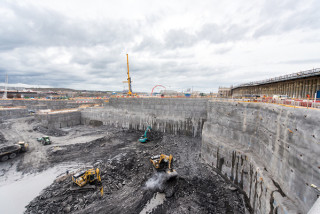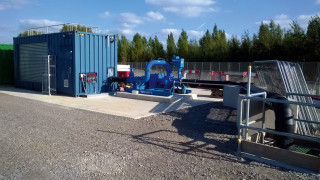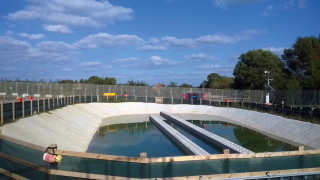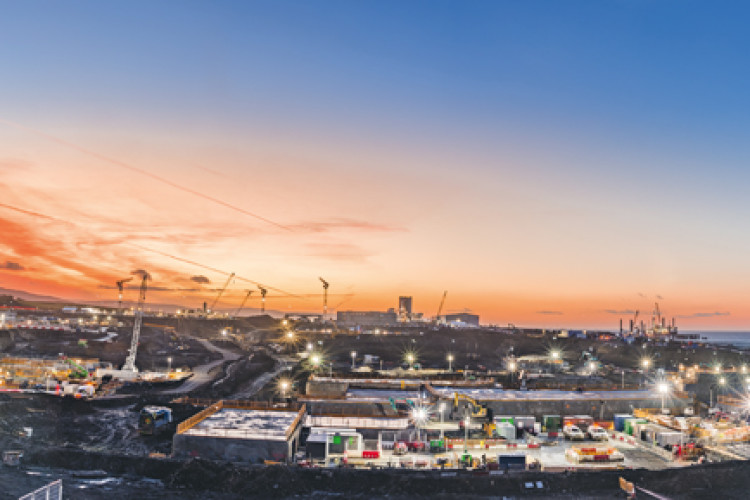EDF’s new nuclear power station at Hinkley Point C, in Somerset, is one of Europe’s largest and most complex infrastructure projects. It is also one of the UK construction industry’s prize schemes, promising around £20bn-worth of work. When it’s completed, it will be the world’s most expensive nuclear power station.
The first reactor is already on track for commissioning in 2025 and this year will see the project hit a number of major milestones, including the completion of the 4,500-tonne platform that will form a base for the reactor buildings.
It’s still early days for main contractor Kier BAM JV, however. Construction of the network of tunnels needed to carry cabling and piping started in March 2017, along with work to construct a jetty and seawall. The accommodation blocks needed for the huge team of skilled trades required for a project of this size and scope, including 1,000 apprentices, have also been completed.
One of the challenges of managing a site of this size and complexity, particularly given its low-lying coastal location, is the issue of managing rainfall and the tidal surges from the sea. To help manage this, Kier BAM has divided the vast site into six water managements zones (WMZ) and enlisted the help of pump hire specialist Sykes Pumps to provide the varied pumping solutions required for each WMZ over the course of the programme.
One of the first tasks for Sykes Pumps was to provide a solution to manage the huge surges in flow caused by the incoming tide during construction of the sea wall.
Job Koning, senior agent for Kier BAM, explains: “While the work area is dry at low tide, at high tide we need to be able to pump 350 litres of water per second away from the site. The best approach for this was a submersible pump designed for high flow rates and high heads.”
But, says Koning, while these are probably the most significant flow rates Kier BAM will ever have to deal with in terms of water management during the construction phase, the predictability of the tides meant a relatively simple pumping set-up was adequate, with manual controls to activate the pumps to run as and when required by the tide.

Far more variable and unpredictable are the requirements for managing groundwater and rainfall across the site. “The provision for each WMZ is based on 100-year storm levels,” says Koning. “Using data from the last century, we have considered what the worst-case scenario would be if rainfall were to be as bad as it has ever been over that 100-year period and we then provided Sykes Pumps with the maximum flow rate requirements based on those calculations.

“It may be far beyond what would usually be expected for a construction site but this is no ordinary construction site and even a minor delay could lead to major knock-on effects on the programme.”
Sykes therefore has a quantity of standby equipment kept on site. And to ensure a rapid response, the company has a team of four engineers based permanently on site throughout the pump hire contract. Reliability to ensure 100% availability is crucial, and so each piece of equipment is inspected and serviced every 14 days.
Dan Greenberry, who heads up Sykes Pumps’ site team, says: “On a large site like this, with a variety of equipment in constant or regular use, there will always be a need to tweak the set-up here and there or respond to changes in ground conditions or flow rate requirements.
“The WMZ strategy is about facilitating the construction programme and it’s a team effort which includes our engineers on site and at our Bristol depot, where more pumps are on standby for rapid deployment should they be required.”
In addition to keeping the site dry, Sykes Pumps has to ensure that the water removed from the site is not simply pumped out into local watercourses. Instead, it is stored in a series of settlement lagoons for treatment before being pumped back into the natural environment in a controlled way.
“Some of the excavations required at Hinkley Point C are as deep as 35m, which not only means a lot of water but also a lot of silt and sediment too,” says Koning. “That’s why water storage lagoons are a critical element of the water management strategy. They allow us to test the water before it’s returned to natural watercourses as part of the client’s commitment to ensuring environmental best practice.”


The equipment supplied by Sykes includes a number of super-silenced Super Wispaset 100 four-inch diesel pumps and Super Wispaset 150 six-inch pumps which are fully-bunded to prevent oil or fuel leaking onto the site. Many of the pumps have been provided with dedicated fuel cubes, while the remainder are topped up with fuel on an ‘as needed’ basis.

“The number of diesel pumps on site has varied throughout the programme so far and we have worked flexibly with Kier BAM to manage pump capacity in line with the programme,” says Dan Greenberry.
“At one point there were more than 80 pumps on site but that level of capacity was only needed during the deeper excavations and as WMZ are established the site-wide diesel pump requirement has diminished.”
The Kier BAM team carries out daily checks of all the pumps on hire, topping up fuel and oil as required. This is backed up by fortnightly service visits and a 24-hour call-out service. Most of the pumps have been provided with a float switch-based control system to ensure that they will always kick in automatically should water levels rise, without running unnecessarily during periods of drier weather. This cuts energy costs and reduces the day-to-day management required.
“Although the specification has prioritised resilience, we have also been focused on making the pumping solution as efficient as possible,” says Greenberry. “The Kier BAM team has been able to move pumps to different locations around the site in response to changes in their groundwater management needs and we provided kilometres of hose to ensure that water can be discharged into the storage lagoons regardless of the pumps’ location.”
In addition to the diesel units, Kier BAM has also bought a number of specially-modified surface-mounted electric pumps to take the stored groundwater out of the settlement lagoons in each of the WMZ. These are used in combination with filtration units which have been specially designed to separate suspended solids and sediment from the water before it is released back into natural watercourses. The cleaned water can then be tested for impurities before being discharged.
Kier BAM ordered a total of 14 modified electric surface mounted pumps for deployment across the six WMZ; seven 22kW units and seven 55kW units. These are installed and configured as each of the WMZs are activated, providing a pump capacity ranging from 96 litres/second to 320 litres/second depending on the precise need.
“It is likely that we will need to manage water levels in each of the WMZ for around a decade because of the length of the programme for such a major project,” says Koning. “Consequently, it made sense to buy these assets from Sykes to ensure that they met our requirements.”
Sykes Pumps has converted the electric pumps to automatic self-priming units and added ultrasonic control systems linked to a control room housed in a container unit for each WMZ.
Bob Lima, the Sykes Pumps engineer who designed and implemented the modifications, explains: “The control systems fitted to the pumps mean that they are extremely low maintenance and will respond rapidly to water conditions in real time.
“Each WMZ has been specified with a pumping capacity that meets the maximum 100-year resilience required for the specific location and the controls mean that the storage lagoons can be maintained at optimum levels at all times with automated adjustments to flow rates and rapid start-up of the pumps with automated priming,” says Lima.
“The system also provides fault monitoring and the flow will automatically switch from duty pump to standby in real time if a fault is detected, enabling the Kier BAM team to call our engineers out for a maintenance visit without any interruption to water management regimes.”
The ultrasonic controls work on a Windows-based system that collects weather data and predicts water levels based on rainfall patterns. Thanks to the variable-speed motors fitted to the pumps, the controls can then adjust the flow rate in line with water storage lagoon levels. As the lagoon level rises, the pumps will transfer water into the filtration units where it will be cleansed before being tested and discharged.
All the site pump installations are due to be completed by the end of this year. A concrete plinth will be built for each WMZ and the pumps will be craned into position before being fixed permanently in position. Kier BAM will then install the pipework and the Sykes Pumps team will complete the installation by carrying out the final connections and commissioning the system to ensure the control system and equipment are working effectively.
This article was first published in the April 2019 issue of The Construction Index magazine
UK readers can have their own copy of the magazine, in real paper, posted through their letterbox each month by taking out an annual subscription for just £50 a year. Click for details.
Got a story? Email news@theconstructionindex.co.uk



